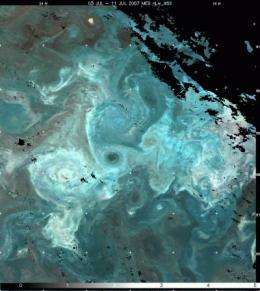Ocean stirring and plankton patchiness

Computer simulations performed by researchers at the National Oceanography Centre and the University of Glasgow show how oceanic stirring and mixing influence the formation and dynamics of plankton patches in the upper ocean.
Tiny free-floating marine plants called phytoplankton live in vast numbers in the sunlit upper ocean. Through the process of photosynthesis, they build carbon compounds such as sugars starting with just water and carbon dioxide, which is thereby drawn down from the atmosphere.
Phytoplankton also need nutrients such as phosphate and iron, shortage of which can limit their population growth. They are also preyed upon by tiny planktonic animals called zooplankton.
"Interactions between phytoplankton, nutrients, zooplankton and the physical environment lead to complex dynamics, which we seek to understand using computer models," explained Emma Guirey, whose work on the problem was done as part of her PhD studies. "These complex dynamics can produce the patchiness of phytoplankton at the ocean surface that is invariably seen in satellite images and observed at sea during research cruises."
Guirey and her colleagues applied the methods of synchronisation theory - previously used to explain such phenomena as the co-ordinated flashing of fireflies along whole riverbanks. Initially they studied the balance between localised increases in phytoplankton populations and small-scale mixing, such as that due to breaking waves, in creating patches. Patchiness was found to persist despite the mixing which might be expected to smooth out the patches by blending them together.
The initial studies neglected the effects of stirring, or 'advection' by large scale ocean currents such as the Gulf Stream and Kuroshio, but this is included in the most recent computer simulations. This stirring stretches the patches out into long filaments. However, the patches still resist dispersal.
"What is exciting is that the inclusion of large-scale advection, far from disrupting plankton patchiness, actually creates the kind of filamentary structure that we often observe in real-life plankton populations. Application of synchronisation theory has given us a new perspective on the production of this complex patchiness," said Guirey.
More information: Guirey, E., Bees, M., Martin, A. & Srokosz, M. Persistence of cluster synchronization under the influence of advection. Physical Review E 81, 051902 (2010). DOI:10.1103/PhysRevE.81.051902
Provided by National Oceanography Centre, Southampton
















